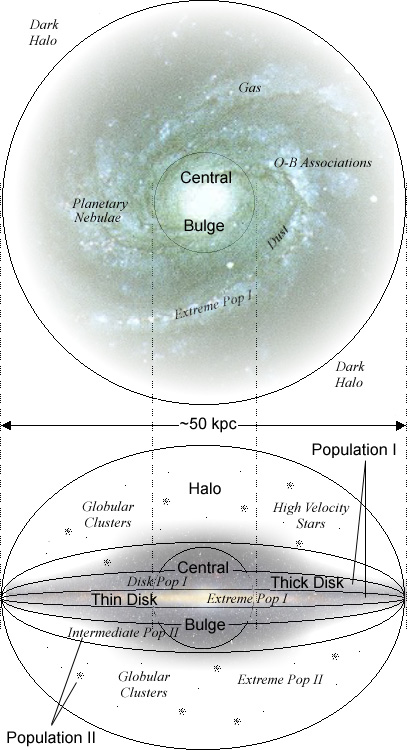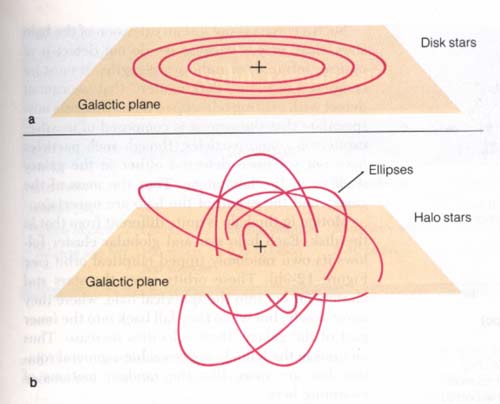| Physics 202 |
Intro to Astronomy: Lecture #24
|
Prof. Dale E. Gary
NJIT
|
Galaxy Evolution
Seeing Galaxies of the
Past
Because we see distant
objects as they were in the past, all we have to do to learn how galaxies
evolve is to look at more and more distant galaxies, which show us what
they were like earlier and earlier in the history of the universe.
Galaxies 5 billion light years away must be at most 14 billion - 5 billion
= 9 billion years old. Galaxies 10 billion light years away must
be at most 4 billion years old, and so on. What is remarkable about
galaxy formation is that we can see galaxies all the way to the limit of
our present telescopes, about 12 billion light years away. These
galaxies are only 1 or 2 billion years old, which means that galaxies formed
very early in the universe. We see little evidence that galaxies
are still forming -- apparently whatever caused their formation took place
in only a short time. Observationally, we have several problems with
seeing galaxy formation by looking farther into space (and farther back
in time):
-
Very distant galaxies are very
faint, and we cannot see them very well even with the largest of today's
telescopes. New, super-sized telescopes are planned, to allow us
to see even farther into the past.
-
Very distant galaxies have very
large recession velocities -- they are moving away at a good fraction of
the speed of light. This causes extreme doppler redshifts, which
means that distant galaxies are brightest in the infrared part of the spectrum.
To observe these, we need to put large infrared telescopes into space.
-
Galaxies formed so quickly that
it is not easy to see differences in galaxies until we reach close to the
limit of our current capabilities.
We would like to tell you the
complete story of galaxy formation, but much still remains hidden to us.
Instead, we can only outline the current ideas, and tell how it might have
happened. We will see that some of the brightest objects in the early
universe are objects called quasars.
Luckily, quasars are so bright that we can see them nearly to the edge
of the universe. The light from quasars pass through many galaxies
between us and the quasars, and this lets us study these intervening galaxies
by looking at the spectral lines they absorb from the quasar light.
Quasars appear to be something that happened only in the early universe,
and we see no nearby quasars today.
Galaxy Formation
We can learn a lot
about galaxy formation by studying the parts of our own galaxy. Recall
the schematic view of a spiral galaxy like our own:
 Here we see that there are objects
(stars and globular clusters) in a more-or-less spherically symmetric "halo,"
which becomes thicker toward the center to make up the central bulge, but
there are other objects (young stars, dust and gas, etc.) that are concentrated
in a thin disk. From this we envision that our galaxy formed from
a more-or-less spherical cloud of hydrogen and helium that collapsed due
to gravity, just as our solar system formed from a far smaller cloud.
In the early history of the collapsing cloud, the cloud would have remained
cool due to radiating its heat away, so particularly dense regions would
have formed the globular clusters and halo stars.
Here we see that there are objects
(stars and globular clusters) in a more-or-less spherically symmetric "halo,"
which becomes thicker toward the center to make up the central bulge, but
there are other objects (young stars, dust and gas, etc.) that are concentrated
in a thin disk. From this we envision that our galaxy formed from
a more-or-less spherical cloud of hydrogen and helium that collapsed due
to gravity, just as our solar system formed from a far smaller cloud.
In the early history of the collapsing cloud, the cloud would have remained
cool due to radiating its heat away, so particularly dense regions would
have formed the globular clusters and halo stars.
It is important to realize
that once a star forms, it will not change its orbit to form a disk of
stars. It will forever orbit at whatever inclination angle it was
when it formed. By studying the orbits of globular clusters and halo
stars, we can see that the gas of the original protogalaxy cloud was once
more spherically distributed. However, the gas that remained did
continue to collapse toward a thin disk, because the gas molecules could
interact and lose their random motions. The law of conservation of
momentum was at work to ensure that the remaining gas clouds orbited close
to the plane of the disk. Stars that formed later, when the gas was
more and more nearly a disk, kept their inclinations just as the halo stars
did, so stars in the thick disk should be older than stars in the thin
disk. In fact, stars in the halo and thick disk should be among the
oldest stars in the galaxy, and because the original cloud was only hydrogen
and helium (no heavier elements) the oldest stars should have no heavy
elements (metals). In fact, we do see that the halo and thick disk
stars are older and have fewer metals, while disk stars are younger and
have more metals.

Why Do Galaxies Differ?
Last time we learned
about the different types of galaxies, especially spiral galaxies and elliptical
galaxies, which are very different in their characteristics. The
cloud collapse idea we just covered can explain spiral galaxies, but how
can we explain the ellipticals, which never form disks at all?
There are several different
explanations to account for ellipticals, and perhaps some ellipticals formed
in one way and others formed in another way. One idea is that the
clouds
that formed ellipticals were somehow different from the clouds
that formed spirals. Since the clouds are all made of the same stuff
(hydrogen and helium), something else would have to be different.
There are two scenarios:
-
Lack of Rotation: Perhpas
the initial cloud simply had very little angular momentum (very little
rotation). If this were the case, no disk would form and the stars
would remain rather evenly distributed in the cloud. However, this
would suggest that ellipticals would have dust and gas from generations
of stars, but the gas would be distributed throughout the elliptical.
In fact, ellipticals seem not to have any dust at all.
-
Rate of Cooling: If the
protocloud were cool enough, so many stars would form early on that there
would have been little dust left to form a disk. One way to make
the cloud extra cool would be to make it have a high starting density.
Evidence for this scenario comes from very distant ellipticals, which
seem to be redder than their recessional redshift would give. These
galaxies must have no young blue or white stars, indicating that there
is no new star formation going on, even though they are only a few billion
years old.
There is another possibility
that could explain ellipticals that does not rely on the initial cloud
being different. This scenario suggests that ellipticals form due
to galactic collisions and mergers.
-
Shaped by Collisions:
We know that collisions among galaxies are quite common. Recall that
galaxies are very different from stars in this respect. Stars are
so far apart relative to their size that they essentially never
collide. Recall that if we scale things down so that the Sun were
the size of an orange, Alpha Centauri (the next nearest star) would be
another orange separated by 3000 miles. If we then think about shrinking
the galaxy to the size of an orange, then the Andromeda galaxy would be
another orange only a few meters away! So relative to their sizes,
galaxies are much much closer together. And recall that the universe
is expanding. In the distant past, when the universe was smaller,
the distance between galaxies was far smaller than it is today.
What would a collision do to
a pair of galaxies? All of the stars in the two galaxies would pass
completely by each other, without collisions, but the gas and dust would
interact and be left behind. The two stellar populations could eventually
merge into a more-or-less spherical shape due to their mutual gravitational
interactions, while the gas and dust might be left behind, or might sink
to the center of the galaxy and form a huge region of new stars.
Such a huge region would eventually produce supernovas that could generate
shocks and wind that could clear out the gas.
Let's look at a
few galactic collisions in progress.
One thing that is clear,
is that the giant ellipticals at the centers of clusters
of galaxies show lots of evidence of mergers and collisions.
The interiors of some giant ellipticals show that stars are orbiting in
opposite directions! They also show multiple nuclei, as if several
large galaxies had been gobbled up. Such giant ellipticals are 10
or more times more massive than individual spiral galaxies. You can watch a video that describes the future of our own galaxy, when we collide with the Andromeda Galaxy.
See also M82
and starburst galaxies.
Quasars and Active Galaxies
Some galaxies are
called "active galaxies" because they have some sort of engine in their
nucleus that is producing huge amounts of energy, sometimes 100s of times
higher than a normal galaxy. The very brightest and most energetic
are called quasars, which is a shortening of the term quasi-stellar
object. As we mentioned earlier, quasars and other active
galactic nuclei are a product of the early universe, and nearby (and hence
present-day) galaxies do not seem to show such activity. It may be
that the engine is present in nearby galaxies (even our own), but is currently
not active.
For many years the cause
of the phenomena seen in active galactic nuclei was completely unknown,
but now we believe that all can be explained by a central, super-massive
black hole in the nucleus of some galaxies. These giant black holes,
of sometimes billions of solar masses, are active when new matter is being
fed to them in accretion disks. The accretion disks produce lots
of X-rays and ultraviolet light. The magnetic fields threading the
disks create jets
of particles that zoom far out into space to form radio
galaxies.
Using
quasars to probe the universe.
